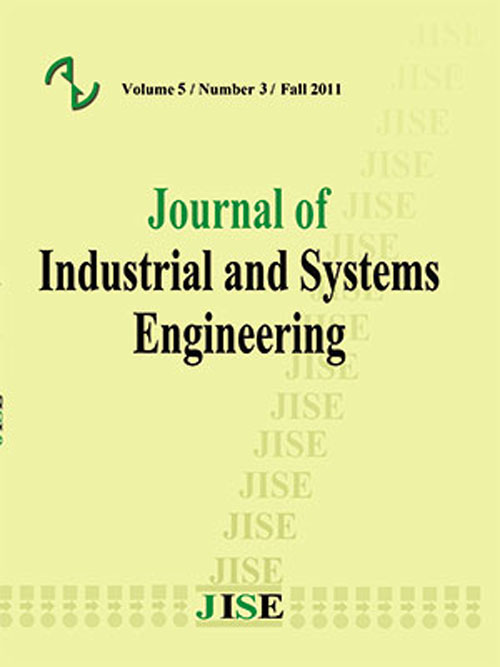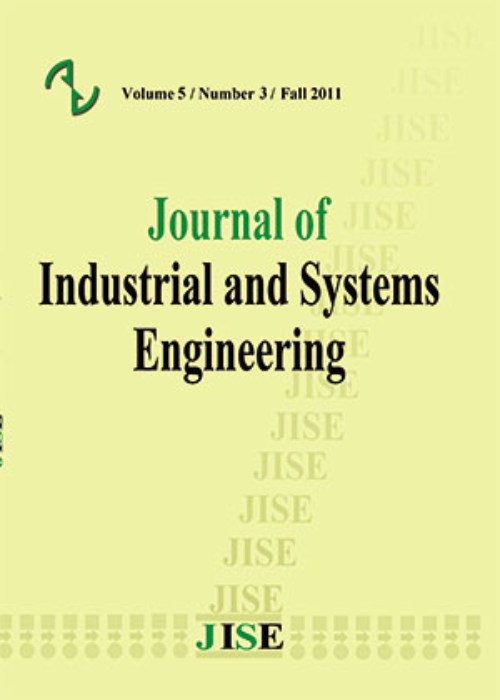فهرست مطالب

Journal of Industrial and Systems Engineering
Volume:10 Issue: 1, Winter 2017
- special issue on healthcare
- تاریخ انتشار: 1396/02/20
- تعداد عناوین: 6
-
-
Pages 1-9Complex institutions comprising several divisions and departments such as hospitals need access to information. Hospital information system has many capabilities and in case this system is acceptance by hospital staff, it leads to a revolution in the health care delivery industry. The identification of effective determinants and measures on the success of hospital information systems could significantly lead to the improvement of their performance. In this paper, the effective determinants and measures on the success of hospital information systems have been identified and then the data has been collected with the help of two customized questionnaires and finally analyzed with inferential statistics using SPSS software. According to the questionnaires, the results of the collected data were divided into two groups: results of experts and those of system users. In the experts group, after identifying the measures and determinants from the literature, they were presented to experts and with the use of one sample T test, the influencing measures and determinants on the success of hospital information systems have been identified. These measures were provided to users and then the confirmatory factor analysis was performed to assess the validity of questionnaires and structure of the identified determinants from the users opinions. Finally, several linear regression analyses were conducted to examine the hypotheses and proposed a model to improve user satisfaction in hospitals.Keywords: Hospital information system, assessment determinants, Delone, Mclean model
-
Pages 10-23Effective preventive healthcare services have a significant role in reducing fatality and medical expenses in all human societies and the level of accessibility of customers to these services can be considered as a measure of their efficiency and effectiveness. The main purpose of this paper is to develop a service network design model of preventive healthcare facilities with the principal objective of maximizing participation in the offered services. While considering utility constraints and incorporating demand elasticity of customers due to travel distance and congestion delays, optimal number, locations and capacities of facilities as well as customer assignment o facilities are determined. First, the primary nonlinear integer program is transformed, then the linearized model is solved by developing an exact algorithm. Computational results show that large-sized instances can be solved in a reasonable amount of time. An illustrative case study of network of hospitals in Shiraz, Iran, is used to demonstrate the model and the managerial insights are discussed.Keywords: Preventive healthcare, Service System Design, Elastic Demand, Utility, Accessibility, Nonlinear Integer Programming
-
Pages 24-54The location of facilities anywhere in an area in which several competing facilities already exist and serving the demand points has been brought to light in this work. Because of the great importance of health care systems in the health of the people, these systems have been studied in the present paper. Creation and maintenance of competitive advantage in health care systems requires optimizing the location decision and understanding customers behaviors. Customers behavior is considered and explicitly modeled in this work. Each facility attracts customers within a sphere of influence defined by a gravity-like spatial interaction model. Customers have full control over which system they choose to patronize and they do so by applying the attractive elements with each center. the attractive factors that affect the user choice behavior are: the lower travelling time, the quality of the services or the reputation of centers. We also investigate how various parameters will affect the market shares of ours and competitors facilities in the user choice environment. The hospitals have several low level sections to offer low level services (such as primary services) and several high level sections to offer high level services (such as professional services) and the patients will refer to different sections of the hospitals according to their requirements and their health status. Two metaheuristic algorithms including ant colony optimization and tabu search are developed to solve the model and be applied to some numerical examples. TOPSIS method and statistical t- test are performed to evaluate the results of the proposed algorithms.Keywords: Discrete network location, Competitive environment, Health Care System, Hierarchical structure, Queuing theory, Consumer choice behavior
-
Pages 55-80Perishability of blood products as well as uncertainty in demand amounts complicate the management of blood supply for blood centers. This paper addresses a mixed-integer linear programming model for blood platelets production planning while integrating the processes of blood collection as well as production/testing, inventory control and distribution. Whole blood-derived production methods for blood platelets (i.e., buffy coat and platelet-rich plasma methods) are particularly focused in our research. The problem is tackled with the aim of minimizing the supply chain total cost. To capture inherent uncertainty of input data, a robust programming approach is devised. A set of numerical experiments is carried out to evaluate the performance of the proposed model and the solution technique. Thereto, we employ two criteria: the mean and standard deviation of constraint violations under a number of random realizations to measure the quality of solutions achieved by both the proposed deterministic and robust models. Finally, several sensitivity analyses are accomplished to provide valuable managerial insights. The results imply the domination of robust approach over the deterministic one.Keywords: Blood supply chains, Healthcare, Platelet-Rich Plasma, Buffy Coat, robust optimization
-
Pages 81-96One of the most fundamental components of healthcare system on each country is blood supply chain management. This chain is comprised of two significant components including collecting donor bloods and supplying bloods products. The main purpose of this paper is to concentrate on supplying blood products and present a novel constrained bi-objective mathematical model for a two-echelon blood supply chain network (BSCN) in order to 1) minimize products waste and shortage costs in hospitals and 2) to minimize the maximum unsatisfied demand of different products among hospital demands supplied by blood transfusion centers. Some techniques are used to linearise the models nonlinear terms and decrease presented models complexity. Then, a multi-choice goal programming (MCGP) technique is used to convert bi-objective model into a single objective one. The model is solved on GAMS software under 3 different scenarios and 18 time periods in real-world BSCN. Computational results showed that hospitals are tended in accepting products holding and waste costs to satisfy demands of patients who are highly need for receiving blood products.Keywords: Blood supply chain, packed red blood cells, MCGP, Blood transfusion center
-
Pages 97-115In this paper, a multi-period and multi-resource operating room (OR) scheduling and rescheduling problem with elective and semi-elective (semi-urgent) patients is addressed. A scheduling-rescheduling framework based on the so-called rolling horizon approach is proposed to solve the problem. The core of the proposed framework is a novel proposed mixed-integer linear programming (MILP) model with the objectives of minimizing tardiness, idle time and overtime. Pre-operative holding unit beds and recovery beds as important resources in surgery departments are taken into account. At first, a schedule is set for all of the days of the planning period. Then, at each iteration, the scheduled patients are fixed (frozen) for the first day of the planning period and a rescheduling is done due to arrival of the semi-urgent patients. Then the planning period is shifted. This process continues until all days of the planning horizon are covered. Numerical analysis and comparisons are done between the proposed approach and two scenarios which are applied in many hospitals. In the first scenario, the semi-urgent patients would be operated in the first available OR after operating elective patients and in another scenario, a specified amount of capacity is allocated for semi-elective patients. The outcomes conclude that the proposed method has much better performance and also statistical test supports this superiority. Finally, a case study is implemented in a hospital in Iran. Numerical analysis shows that our proposed approach surpasses the actual schedule of hospital significantly.Keywords: Operating room scheduling, Healthcare, rolling horizon framework, rescheduling approach, elective, semi-urgent patients, resource constraints


